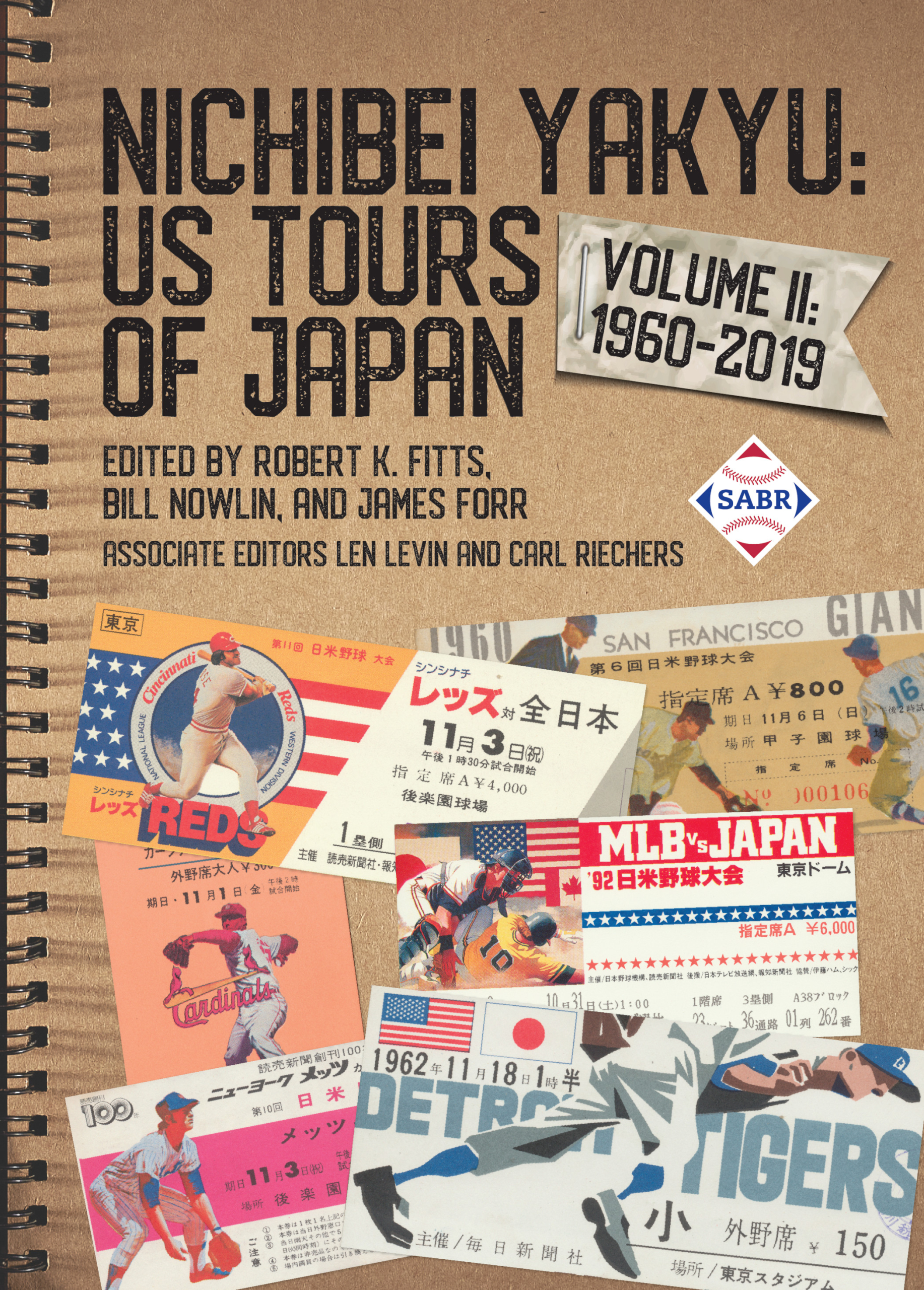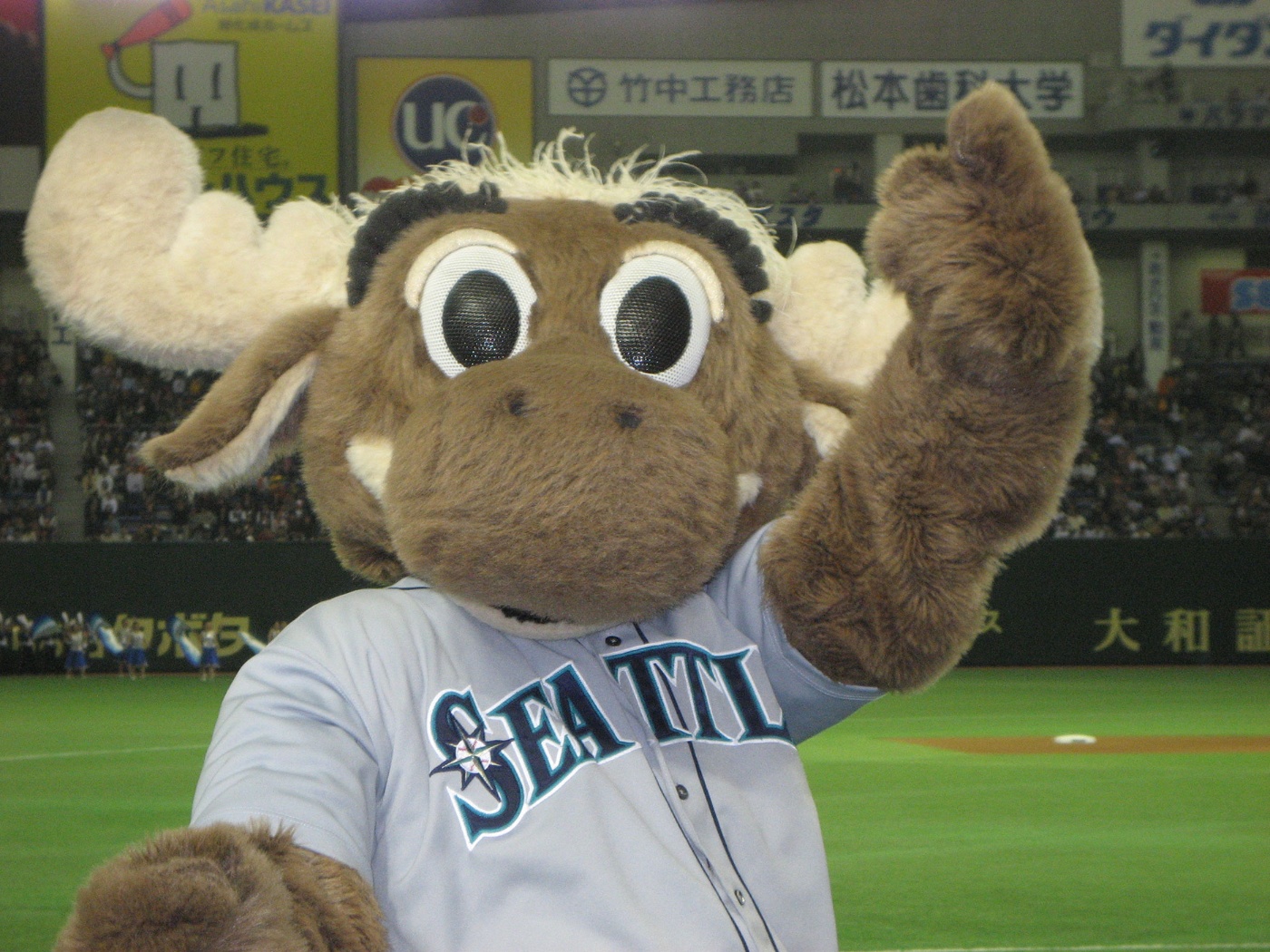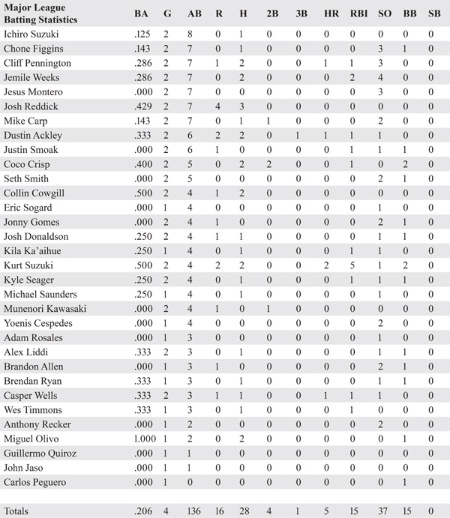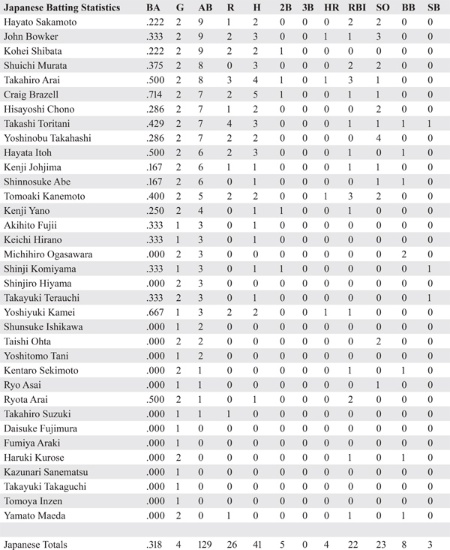2012 MLB Opening Series: Mariners vs Athletics at the Tokyo Dome
This article was written by Susan Miyagi McCormac
This article was published in Nichibei Yakyu: US Tours of Japan, 1960-2019
The Mariner Moose entertaining fans at Tokyo Dome. (Photo by Robert Fitts)
On March 11, 2011, a magnitude-9.1 earthquake struck off the northeastern coast of Japan’s main island of Honshu, near a region known as Tohoku.1 The quake triggered a tsunami, and the world watched in horror as the black waves – some as high as 130 feet – crashed over floodwalls and raced inland, eating the shoreline, and destroying buildings, cars, and lives.2 The resulting meltdown at the Fukushima Daiichi Nuclear Power Plant, located 43 miles from the epicenter of the earthquake, forced mass evacuations and caused more loss, devastation, and uncertainty. The death toll from the Great East Japan Earthquake stood at 19,747 precious lives, and 2,556 were still missing a decade later.3
One year after the triple disaster, two major-league teams, the Seattle Mariners and the Oakland Athletics, began the season in Tokyo. It was the fourth season-opening series in Japan and the first since 2008, when the Athletics faced the Boston Red Sox. (The others were the Yankees and the then-Devil Rays in 2004 and the Mets-Cubs series in 2000.) When Major League Baseball announced the Opening Day plan six months earlier, in late September 2011, Commissioner Bud Selig said the decision to begin in Tokyo was largely for humanitarian reasons.
“Opening Series 2012 will be an excellent opportunity to bring the game of baseball to fans across the globe and to celebrate the many contributions to the game by Japanese players,” Selig said in a statement. “Most importantly, with the shared love of baseball between our nations, I believe that we can use this event to further assist the ongoing relief efforts throughout Japan.”4
That charitable sentiment seemed to be lost on West Coast fans once the games were played on March 28 and 29, 2012.
“Why Are the A’s and Mariners Playing Baseball in Japan?” asked an agitated Wendy Thurm on SB Nation.5 She complained that A’s fans couldn’t watch the games for two reasons: First pitch (3:05 A.M. Pacific Time) happened before anyone on the West Coast was awake, and even if fans dragged themselves out of bed in the middle of the night, there was nothing to see but a blank screen because MLB’s blackout restrictions rendered the game unavailable in the Athletics’ and Mariners’ home viewing territories. (The MLB Network showed both games on tape delay at 6:00 A.M. and 7:00 P.M. Pacific Time each day.)6
John Swol, a Minnesota Twins fan who runs the blog Twins Trivia, denounced the two-game series in Tokyo in his blog post “Season Opener in Tokyo? Just Plain Wrong.”7 Like Thurm, Swol thought it was unfair to Athletics and Mariners fans – and baseball fans in general – to stage games in a time zone that’s 16 hours ahead of the West Coast.
“Baseball is America’s pastime and opening the season after the long winter away from baseball in a foreign country is just plain wrong,” the blogger bellyached. He wondered aloud if someone was receiving financial benefit from this venture, then asked, “Why in Japan, why not in the Dominican, Puerto Rico, Australia, or even Cuba. Is MLB looking to put a big league team in Tokyo?”
Perhaps Mr. Swol didn’t realize that, while baseball may be America’s pastime, it was first introduced to Japan in 1872.8 And the answer to his last question is “No,” of course. The answer to his question about who benefits is, well, Major League Baseball. “Almost 70 percent of MLB’s international revenues are derived from the Japanese market,” Tom Verducci wrote in Sports Illustrated, describing starting the season in Japan as “a smart move by MLB.”9
“Playing regular season games in Japan for a fifth time in the past 14 years has helped drive such interest,” Verducci continued.10 “Last year [2011] MLB opened an official MLB of Japan online shop, and for years it has sold virtual signage to Japanese companies to insert into the MLB International broadcasts of All-Star, LCS, and World Series games.”11
Verducci made the case for what’s in it for the Japanese fans. And, at the time of his article, there was a slim chance that NPB legend and former Yankee Hideki Matsui would re-sign with Oakland and play in the 2012 opening series. (He didn’t.) “[I]t is fitting that Japanese fans get a chance to watch [Ichiro] Suzuki, one of their most beloved stars, play in his homeland in a major league uniform for the first time,” Verducci wrote. “Japanese baseball fans have been watching Mariners games on television for years, and the opportunity to welcome him back as an active major leaguer is in itself worth the trip.”12
Despite the feelings of annoyed writers like Thurm and bloggers like Swol, the players, as well as the coaches and staff, agreed with Verducci and seemed happy to participate. “The fans over there love the game,” A’s left fielder Coco Crisp told MLB.com ahead of the series, saying he was looking forward to the experience after playing in Japan during the 2008 opener as a member of the Boston Red Sox. “You’ve got people hanging fishing rods over the wall with cards to sign, balls attached to all sorts of different things. They really get into it.”13
“This is a great opportunity,” A’s general manager Billy Beane said. “We want to thank everybody in Japan who have welcomed us again. We came here in 2008, and we were more than happy to come back again.”14 “It’s an honor and a privilege to be here,” Mariners manager Eric Wedge said. “I know all the players are excited to be in Japan. Baseball has truly become an international sport, and I think the opportunity to come over here and play Oakland and open this year’s major league season is quite an opportunity.”15
Mariners shortstop Brendan Ryan proposed to his girlfriend, Sharon, while in Tokyo. He learned how to ask her in Japanese because she had spent time in Japan as an English and dance teacher. It was a surprise he’d been planning since the trip was announced.16
Ryan’s teammate Tom Wilhelmsen, a reliever, toured Tsukiji Fish Market and then watched his team’s American League West rivals play an exhibition game against the Hanshin Tigers while wearing Tigers gear. “It was a lot of fun,” Wilhelmsen said of the game. “They have a different song for every player and every situation. It was pretty good. Once they scored a run, they turned around to me and I was able to knock ThunderStix with them. That was pretty darn cool. You can’t beat that.”17
Before the major-league season officially started, each team played exhibition games against the Yomiuri Giants and the Hanshin Tigers, including the one Wilhelmsen attended as a fan. Those games began with a day-night doubleheader on Sunday, March 25, 2012.
More than 42,000 people attended the matchup between the Hanshin Tigers and the Seattle Mariners, partly because the Osaka-based Tigers have a rowdy and loyal fan base that travels well, but also because Japanese fans were eager to see Ichiro Suzuki. Although he had represented the Japanese national team in the World Baseball Classic and participated in major-league tours of Japan, this would be his first time to play a game in Japan as a major leaguer since he became a Mariner in 2001.18
With every Ichiro at-bat, flashbulbs lit up the Tokyo Dome as if it were the Fourth of July. The superstar, who spent nine years with the Orix Blue Wave before becoming the first Japanese-born everyday position player in major-league baseball, went 1-for-4 against Hanshin as the Tigers won 5-1. In the bottom of the second, Hanshin got a little help from former Mariners catcher Kenji Johjima, whose infield single scored Tigers third baseman Takahiro Arai from third. Seattle starter Hector Noesi then gave up a two-run homer to Tomoaki Kanemoto en route to the loss. His final line was three runs and six hits in five innings. A Kohei Shibata double and a single by Takashi Toritani gave the Tigers two more runs in the seventh.19
The nightcap between the Oakland Athletics and the Yomiuri Giants was somewhat more subdued, despite being on the Giants’ home turf. Ichiro may have received the most attention at the Tokyo Dome, but on this day another Suzuki made more noise. Oakland catcher and Hawaii native Kurt Suzuki cracked a two-run home run in the seventh inning, and Oakland’s pitchers stifled Yomiuri’s bats, holding the “Yankees of Japan” to two hits in a 5-0 shutout.
The next day saw another day-night doubleheader exhibition, with the teams switching opponents. The early contest pitted Oakland against the Hanshin Tigers. Unlike Hanshin’s exhibition against Ichiro and the Mariners the previous day, the Tigers’ generally large and boisterous oendan (fan club) was sparse. It could’ve been the noon start on a Monday, but it’s most likely attributed to the Tigers’ opponent being the Ichiro-less A’s.
The lack of cheering in the Tokyo Dome didn’t faze the Tigers, as they jumped all over Oakland starter Tyson Ross early, scoring seven runs in the first three innings. Takahiro Arai started the scoring with a two-run home run in the bottom of the first, and the Tigers rolled to a 12-6 win over the major-league team.20 Once again, the “other” Suzuki visiting Japan hit a home run, this one a three-run shot off former Seattle Mariners pitcher Randy Messenger, cutting Hanshin’s lead to 7-4. With Oakland GM Billy Beane watching from the stands, the rally fell short.
The day’s second game was what everyone in Japan wanted to see. A crowd of 43,759 – just shy of the Tokyo Dome’s capacity of 45,600 – politely waited in orderly lines outside the ballpark for their chance to get a glimpse of Ichiro as the Yomiuri Giants hosted the Seattle Mariners. Seattle manager Eric Wedge put three Japanese players in the lineup: Ichiro; shortstop Munenori Kawasaki, a former SoftBank Hawks all-star who signed a minor-league contract with the Mariners; and starting pitcher Hisashi Iwakuma.
Iwakuma signed a one-year deal to pitch for the Mariners in January 2012 after a successful 11-year NPB career. He spent seven seasons with the Rakuten Golden Eagles, culminating in 2011. The March 11 tragedy delayed the start of the 2011 NPB season by three weeks. When the season officially began on April 12, one month and one day after the disaster, Iwakuma toed the rubber for the visiting Eagles at QVC Marine Stadium in a start against the host Chiba Lotte Marines. Many Rakuten fans attended the game, some driving eight hours from the battered Tohoku region, to witness Iwakuma earn the win on his 30th birthday.21 He went 8⅓ innings, giving up three earned runs while walking two and striking out four as the Eagles defeated the Marines 6-4.22 “This is a victory for all of us, including the people trying their best in Tohoku,” Iwakuma said after the game.23
The Eagles are based in Sendai, Miyagi Prefecture, a mere 80 miles from the epicenter of the March 11 earthquake. The damage that the Eagles’ ballpark sustained as a result – cracked walls, flooded suites, collapsed ceilings in offices – forced Iwakuma and his teammates to play six “home” games in ballparks in the Kansai region of Japan, more than 500 miles away. From April 15 through April 17, 2011, the Eagles played three games at Koshien Stadium in Nishinomiya, Hyogo Prefecture, the home of the Hanshin Tigers and the famed high-school baseball tournament. Then they hosted the Nippon-Ham Fighters from April 22 through April 24 at Hotto Motto Field in Kobe, one of two home parks of the Orix Buffaloes.24 Repairs to Kleenex Miyagi Stadium finished quickly, and the Eagles could return to familiar turf on April 29 against the Buffaloes, a complete-game, 3-1 win by future Yankee Masahiro Tanaka.25 Iwakuma would finish his final NPB season with a 6-7 record and a 2.42 ERA.26
One year later, as a newly minted US major leaguer, Iwakuma started the Mariners’ exhibition game against the Yomiuri Giants. It did not go well for him. A crowd of 43,759 packed Tokyo Dome to witness a 9-3 beatdown of the Japanese star.27 The Giants were held to two hits in their 5-0 loss to Oakland on Sunday, but their bats came to life against Iwakuma and Seattle’s relievers. Former San Francisco-turned-Yomiuri Giant John Bowker started the 14-hit barrage with a solo home run in the first inning, and in each subsequent inning, his teammates followed suit: Kenji Yano (RBI double in the second), Shuichi Murata (two-run single in the third), and Hayato Sakamoto (two-run single in the fourth). In Iwakuma’s disappointing outing, he lasted only four innings, surrendering six runs on 10 hits. “I felt like he threw the ball OK,” Wedge said of Iwakuma, the 2008 Sawamura winner. “He just had trouble putting hitters away. He was ahead multiple times and had opportunities to work through innings and just wasn’t able to make that pitch to finish off hitters. If he does that, it’s a different ballgame.”28
While the fans were cheering on the Giants, they were also watching Ichiro’s every move. He was held hitless but had an RBI groundout that scored Dustin Ackley, who also contributed a solo home run and a triple. D.J. Houlton, in his first season with the Giants after four seasons and a Japan Series championship with the SoftBank Hawks, was the winning pitcher. These ballgames showed how global baseball has become: The NPB teams won both contests in the Tokyo Dome that day with American pitchers on the mound, while Seattle lost with a Japanese starter.
As Selig intended when making the choice to begin the season in Japan, MLB did use the Opening Series as an opportunity to help in the 3/11 recovery efforts. On March 27, 2012, a group of players – including Iwakuma – and MLB staff visited Ishinomaki, a town in Miyagi Prefecture that was ravaged by the earthquake and tsunami. They conducted a baseball clinic for young players and met with other residents. “Because I was in that area, I really want to give something back to the local community,” said Iwakuma of his participation.29 The next day, US Ambassador John Roos hosted a ceremony with Japanese government officials at his residence “to celebrate the shared love of baseball that unites our two countries.”30
The visit and ceremony were part of a collaboration between MLB, the MLB Players Association, and the TOMODACHI Initiative, a public-private partnership started in response to the March 11 disaster and led by the US government and the U.S.-Japan Council with support from the Japanese government. The diplomatic alliance was launched during Cal Ripken Jr.’s visit to Japan in November 2011, when the Hall of Famer, appointed a sports diplomat by the US State Department, toured Ofunato, Iwate Prefecture, on a nine-day mission.31 He and former Oriole teammate Brady Anderson conducted a baseball clinic for around 70 junior high school students from the area.
Farther south, Mariners Dustin Ackley, Justin Smoak, and George Sherrill had a high-flying time during a visit to Camp Zama, a US Army base in Kanagawa Prefecture, 25 miles from Tokyo.32 The trio flew to the base in Blackhawk helicopters, an exhilarating ride that showed off the vast expanse of the Japanese capital. Once at Camp Zama, the players took a tour and met soldiers and their families.
With the exhibition games and humanitarian tours completed, it was time for the 2012 major-league regular season to begin. The first game, on March 28, began with a solemn memorial at the Tokyo Dome. The pregame ceremony was a moving tribute to the victims and survivors of March 11, 2011. A video with Derek Jeter, Bobby Valentine, and Ripken Jr. profiled three people connected to the devastated region: Shinji Takai, a farmer in Kesennuma who restored photographs that were damaged by the tsunami; Naho Hozumi, a housewife and stay-at-home mom who became the program manager of the volunteer organization Hands on Tokyo; and Taylor Anderson, a native of Midlothian, Virginia, and a teacher in the JET Program who was one of the more than 19,000 people to perish in the disaster. Anderson’s parents, along with Takai and Hozumi, threw out the ceremonial first pitches. Members of the 296th Army Band based at Camp Zama performed on the field, and Spc. Amanda Tetreault of the 296th sang the US National Anthem. Japanese actor and singer Ryotaro Sugi performed the Japanese National Anthem.
Ichiro made up for his 0-for-exhibition series in the first game that counted. He didn’t disappoint fans on either side of the globe, going 4-for-5 with an RBI as the Mariners won the first game, 3-1, in a briskly played 11-inning game that lasted just over three hours. “I’ve never been that nervous before,” Ichiro said in a postgame interview. “The warmth of the fans almost made me want to cry. … I felt the significance of the occasion. I knew it would only happen once in my life. I wanted to share a special moment and give something back to them.”33 Seattle second baseman Dustin Ackley had a 2-for-5 night with a solo home run in the fourth inning and the game-winning RBI in the top of 11th. He scored an insurance run in the same inning on Ichiro’s RBI single.
Oakland starter Brandon McCarthy and Mariners ace Felix Hernandez practically matched each other pitch for pitch. McCarthy went seven innings, giving up six hits and one run, walking no one and striking out three; Hernandez threw eight innings, allowing a run on five hits with no walks and six strikeouts. Tom Wilhelmsen scouted the A’s well during the exhibition game he attended, as he recorded the win for the Mariners with two perfect innings. Brandon League, a yonsei (fourth generation Japanese American), earned the save.
While Ichiro stroked four hits in the first game, the entire Mariners team could manage only three hits the next day against A’s starter Bartolo Colon. It was a pitchers’ duel between Colon and Jason Vargas; the game was scoreless until Mariners first baseman Justin Smoak led off the seventh inning with a home run. The A’s followed suit with three home runs of their own, including a two-run blast off the bat of Cuban defector Yoenis Cespedes, the first of his young major-league career. Josh Reddick and Jonny Gomes added solo shots, giving Oakland a cushion for its 4-1 victory.
On that night Ichiro went 0-for-4, but he was still a delight for the Japanese fans, who were grateful to see the superstar play in Tokyo. “More than the four hits, it was the atmosphere,” Ichiro said. “Being able to enjoy the atmosphere with the fans. Being there with the same feeling? That was special for me. That’s what will stay with me. Seeing the fans and how they react and welcomed the players. They’re very warm-hearted. It makes you proud.”34
With the backdrop of the March 11 tragedy, the games had a level of poignancy generally not present in baseball (the Braves-Mets first game after 9/11 notwithstanding). The Opening Series in Tokyo humanized the sport and maximized the connections between the United States and Japan through the two countries’ shared love of baseball. Despite the complaints about the time difference between the two countries, it was nothing short of remarkable for Tokyo to host the major leagues’ opening series soon after the one-year anniversary of the strongest earthquake to strike Japan in its recorded history.35
SUSAN MIYAGI McCORMAC is the main graphics operator for the YES Network’s Emmy Award-winning television broadcasts of New York Yankees baseball games. In 2004 she traveled to Tokyo to work the Opening Series between the Yankees and Devil Rays. As a result of that experience, her passing interest in Japanese baseball blossomed into ardent fandom. She’s attended dozens of NPB games in Japan as well as the 2012 Opening Series between the Seattle Mariners and the Oakland Athletics with JapanBall, an international baseball tourism group. Susan’s love of Japanese baseball has strengthened her connection to her Japanese roots. She lives in New York City, where she runs the website JapanCulture-NYC.com and serves on the boards of the Japanese American Association of New York and the JET Alumni Association of New York, the advisory board of the OIST Foundation, and the communications committee of the New York region of the U.S.-Japan Council.
Notes
1 Portions of this chapter previously appeared as separate articles in March 2012 on Susan McCormac’s website, JapanCulture-NYC.com. See “JapanCulture-NYC Explores Tokyo”; “MLB Teams Struggle Against NPB in Tokyo”; and “Mariners, A’s Split MLB Opening Series in Japan,” JapanCulture-NYC.com, March 2012.
2 “On This Day: 2011 Tohoku Earthquake and Tsunami,” National Centers for Environmental Information, March 11, 2021. https://www.ncei.noaa.gov/news/day-2011-japan-earthquake-and-tsunami.
3 “The State of Recovery in Tōhoku 10 Years After 3/11,” Nippon.com, March 10, 2021. https://www.nippon.com/en/japan-data/h00954/.
4 Reuters, “Mariners and Athletics to Open 2012 MLB Season in Tokyo,” September 28, 2011. https://www.reuters.com/article/us-baseball-japan-idUSTRE78R5BS20110928.
5 Wendy Thurm, “Why Are the A’s and Mariners Playing Baseball in Japan?” SB Nation, March 28, 2012. https://www.sbnation.com/2012/3/28/2905260/As-Mariners-opening-day-Japan-mlb-history; Maury Brown, @BizballMaury on Twitter: “Thanks MLB. You Idiots Are Blacking Me Out of a Game … in Japan?!? #FAIL, March 28, 2012. https://twitter.com/BizballMaury/status/184974354810015744.
6 Mike Hiserman, “MLB in Tokyo: Seattle vs. Oakland: Opening Series ‘Special’ to Ichiro, March 28, 2012. Japanese Fans,” tucson.com, https://tucson.com/sports/baseball/professional/mlb/mlb-in-tokyo-seattle-vs-oakland-opening-series-special-to-ichiro-japanese-fans/article_1ac6d842-ddf9-57f4-b6f8-367017b5ef90.html.
7 John Swol, “Season Opener in Tokyo? Just Plain Wrong,” twinstrivia.com, March 25, 2012. https://twinstrivia.com/2012/03/25/season-opener-in-tokyo-just-plain-wrong/.
8 Daniel A. Métraux, “Baseball in Japan and the US: History, Culture, and Future Prospects,” Education About Asia, Volume 21:2 (Fall 2016): Sports, Culture, and Asia, Fall 2016: 42.
9 Tom Verducci, “Starting Season in Japan with A’s-Mariners a Smart Move by MLB,” Sports Illustrated, March 27, 2012. https://www.si.com/more-sports/2012/03/27/japan-opener.
10 Verducci.
11 Verducci.
12 Verducci.
13 “A’s, Mariners Leave for Japan in Preparation for Opening Day,” The Sporting News, March 22, 2012. https://www.sportingnews.com/us/mlb/news/1806381-as-mariners-opening-day-tokyo-japan-2012-season.
14 Jason Coskrey, “Mariners, A’s Begin Preparations for Opening Series,” Japan Times, https://www.japantimes.co.jp/sports/2012/03/25/baseball/mlb/mariners-as-begin-preparations-for-opening-series/, March 25, 2012.
15 Coskrey, “Mariners, A’s Begin Preparations for Opening Series.”
16 Jim Caple, “Season’s Greetings, from Tokyo,” ESPN.com, March 28, 2012. https://www.espn.com/mlb/story/_/id/7747079/mlb-opening-day-always-special.
17 Caple.
18 Alastair Himmer, “Ichiro-mania in Full Force as MLB Season Begins in Tokyo,” Toronto Star, March 27, 2012. https://www.thestar.com/sports/baseball/2012/03/27/ichiromania_in_full_force_as_mlb_season_begins_in_tokyo.html.
19 Jim Armstrong, “Ichiro a Hit in Seattle’s Loss to Hanshin Tigers,” San Diego Union-Tribune, March 25, 2012. https://www.sandiegouniontribune.com/sdut-ichiro-a-hit-in-seattles-loss-to-hanshin-tigers-2012mar25-story.html.
20 “MLB Teams Struggle Against NPB in Tokyo,” JapanCulture-NYC.com, http://www.japanculture-nyc.com/mlb-teams-struggle-against-npb-in-tokyo/, March 28, 2012.
21 Ken Belson, “Solace in the Stadium as Baseball Resumes in Japan,” New York Times, April 13, 2011: Section B, 12. https://www.nytimes.com/2011/04/13/sports/baseball/13opener.html.
22 Nippon Professional Baseball Box Score, NPB.jp, April 12, 2011. https://npb.jp/bis/eng/2011/games/s2011041200224.html.
23 Belson.
24 Dean Ruetzler, Tohoku Rakuten Golden Eagles Team Profile, Hanshin Tigers English News, 2021. https://www.thehanshintigers.com/team-profiles/tohoku-rakuten-golden-eagles/.
25 Nippon Professional Baseball Box Score, NPB.jp, April 29, 2011. https://npb.jp/bis/eng/2011/games/s2011042900378.html.
26 Nippon Professional Baseball, NPB.jp, https://npb.jp/bis/eng/players/01105111.html, 2021.
27 Jason Coskrey, “Iwakuma Shaky as Giants Beat Mariners,” Japan Times, March 27, 2012. https://www.japantimes.co.jp/sports/2012/03/27/baseball/japanese-baseball/iwakuma-shaky-as-giants-beat-mariners/.
28 Coskrey, “Iwakuma Shaky as Giants Beat Mariners.”
29 Coskrey, “Mariners, A’s Begin Preparations for Opening Series.”
30 Press Release, “TOMODACHI, MLB Step Up to the Plate for Japan,” usjapantomodachi.org, March 26, 2012. http://usjapantomodachi.org/2012/03/125/.
31 Associated Press, “Cal Ripken Jr. Visits Japanese Youth,” ESPN.com, November 15, 2011. https://www.espn.com/mlb/story/_/id/7237091/cal-ripken-jr-ex-baltimore-orioles-great-visits-japanese-kids-affected-tsunami.
32 Greg Johns, “Pictures Tell the Story from Blackhawk Trip Over Tokyo,” Mariners Musings, MLB.com/blogs, March 26, 2012. https://gregjohns.mlblogs.com/pictures-tell-the-story-from-blackhawk-trip-over-tokyo-218afa599b6f.
33 Matt Kelly, “Box Score of the Day: Ichiro Returns Home,” MLB.com, March 28, 2020. https://www.mlb.com/news/mariners-played-athletics-in-japan-in-2012.
34 Caple, “Season’s Greetings, from Tokyo.”
35 National Geographic Society, “March 11, 2011 CE: Tohoku Earthquake and Tsunami,” August 10, 2022. https://education.nationalgeographic.org/resource/tohoku-earthquake-and-tsunami.
36 These tables include all participants in the series. “Scores,” MLB.com. https://www.mlb.com/gameday/mariners-vs-tigers/2012/03/24/334529/final/box.








